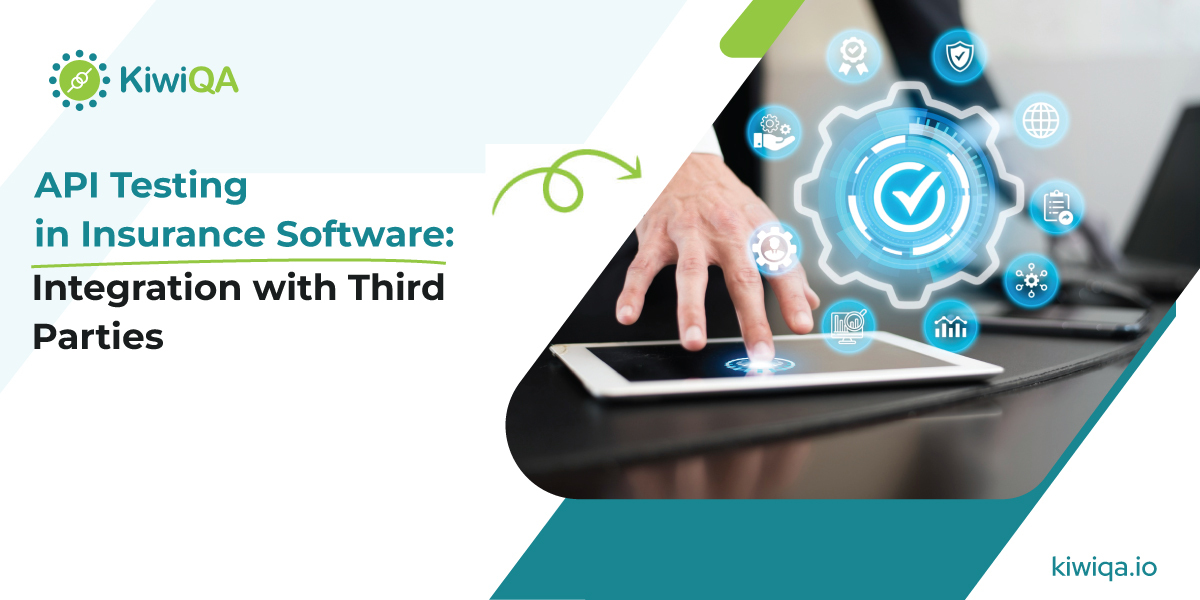API Testing in Insurance Software: Integration with Third Parties

 KiwiQA
KiwiQATable of Contents
Policy management is an important factor in the insurance sector that ensures the efficacy of internal operations. So, policy management needs to be managed by a secure platform and updated software solution.
Because outdated software leads to errors and mismanagement of the operation, the role of API comes into play, offering solutions to the above challenges and effectively enhancing policy administration services.
Another benefit of integrating third-party services into the insurance app testing through API is that it allows users or insurers to exchange data between different systems or third-party healthcare providers or partners.
APIs or Application programming interfaces are groups of defined protocols that ensure two software modules efficiently communicate among themselves. That means data can be easily transmitted and extracted between or outside the organizations.
Whereas API in insurance software testing services creates connections between software components and enables seamless data transfer between several applications to enhance the data exchange among the software systems.
Also, insurers get the benefit of locking the large data files to manage real-world data management risk and customized insurance packages for each individual. They also get the benefits of a data-driven exchange network among third-party investors or healthcare providers.
Today, API testing in insurance software is changing traditional insurance management processes and driving significant digital transformation in internal operations. Some examples of API use in insurance include:
In the traditional way, claim processing was done by collecting and comparing different shreds of evidence across multiple sources to find out if the claim was true or not, and then the reward was processed manually based on the evidence.
But, with the help of API, today, different data are automatically transferred and verified across third-party data resources that ensure the trueness of the insurance claim.
So, insurance API India helps in automated claim processing by reducing risks, increasing the internal operation process in odd situations, and enhancing the customer experience.
API can help boost customer data management by sharing accurate data with partners and obtaining the user’s consent. It also helps to monetize the customer’s data in a centralized database across multiple internal systems and software.
Third-party integration into the insurance sector has several benefits to customers as well as the insurance sector, including:
Some challenges occur in integrating API in the insurance sector. Let’s discuss these challenges.
The insurance sector contains sensitive data of multiple customers. In the traditional system, maintenance can be a daunting task. So, API in insurance software testing services today plays a pivotal role in securing sensitive data effectively.
Also, API is important in insurance security, as it helps to ensure the data is only available to authenticated users or servers. However, sometimes the transferred data through API third-party puts insurers and customers at risk.
Some common security challenges that happen during API integration for insurance are as follows:
To overcome these challenges, API developers should implement encryption security measures in the insurance software sector to take over control of the customer’s data.
Maintaining data integrity in the insurance sector helps ensure accuracy and consistency across systems through several strategic approaches, such as insurance QA software testing through API.
To effectively integrate the data, developers need to validate data through APIs in the following manner:
System interoperability in insurance app testing can be a major concern that leads to compatibility issues between different software systems. That’s why they can be improved in the following manner.
In a nutshell, a constant validating environment can improve system interoperability through API testing modules because the improvement helps in customer satisfaction and smoothens the insurance business operation.
The key components of API testing in insurance QA software testing include response time, appropriate code language, overall load functionality, and different version control systems. One can implement these components by using different types of API software testing methods, tools, and technologies. Let’s discuss the types and tools in the below:
Functional testing in API insurance app testing checks the developed software’s functionality should match the system requirements and the features that are predetermined in the software coding systems.
Some important techniques involved in functional testing include:
The API load testing determines how the developed insurance app behaves in a real-world load condition when multiple users are using the app. This test also helps identify flaws and errors in the software program.
The load test engineers test the software by recording response time, smoke testing, and measuring error percentage to check the system’s ability to cope with the real-world load environment.
It is an important software testing method that checks the potential threats and vulnerabilities to the internal structure of the application programming. The goal is to protect the application from intruders and malicious cyber attacks, preventing unauthorized access to customers’ data.
Different types of security testing include vulnerability analysis to identify threats in the system, penetration testing to find the weak areas of the computer network, SAST, and DAST, and lastly, Ethical hacking to ensure the system is performing well in risk situations.
Some popular tools for API testing in insurance software include:
If you are confused about choosing the right tool for your insurance app testing, you should consider certain factors, including:
A test strategy requires a set of defined objects for your software testing requirements. For that, you should prioritize different test cases based on the risk assessment types. After that, you should define your scope of testing to minimize the errors.
Another thing you should think about when developing a testing strategy is to prioritize risk-based testing to find out which parts of the software applications can be in a risky position to meet the business’s needs.
Benefits of automatic API insurance software testing services include:
Save Time- It helps save the time of the developers so that they focus on other parts of development to deliver the product on time.
Some tips for implementing the test automation include:
The role of CI/CD integration in API development is to help software developers detect bugs early, improve software quality, improve code performance, and provide users with a suitable environment to give feedback freely.
You can easily integrate API testing into CI/CD pipelines by the following steps.
Today, the insurance sector is getting digitally equipped to match the cutting-edge demands of customers. As the insurance sector comprises lots of sensitive customer data, the software has to be advanced as the sector is directly associated with third-party integrations such as partners or healthcare providers.
To make the insurance apps more user-friendly and more secure, developers run API testing at the early stage of insurance app development to ensure the insurance QA software system is running properly without showing errors.
So, API development in software testing is a crucial part that every developer should deploy in the testing process to enhance credibility, sustainability, and trustworthy insurance app deployment and to meet the user’s satisfaction without compromising on their security. So, every insurance company should develop their apps with a professional API test Engineer to enhance the app’s performance!
Join the like-minded community & get the latest updates and insights on software testing technological transformation around the globe. Don't miss out.
